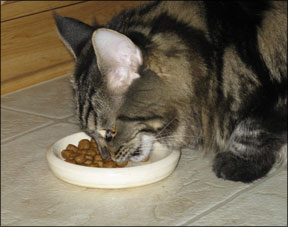One cat knocks its food bowl over and makes a mess on your floor every time it eats. Another cat is a thief. It hops onto your kitchen counter at any opportunity to snatch whatever morsel of food it might spot lying there. A third cat spends a good part of its time gnawing on the clothing it finds in your closet. These are among the more common, puzzling, and often very annoying feline eating- Bev Caldwell 288 related behaviors that, if not appropriately addressed, can seriously compromise the relationship between a cat and its owner. Some such unusual activities, says Katherine Houpt, VMD, James Law Professor of Behavioral Medicine at Cornell University’s College of Veterinary Medicine, can signal the presence of a serious physical disorder and will thus merit the attention of a veterinary nutritionist. Others are merely goofy habits that the cat has picked up and can probably be rectified by an owner. And still other undesirable eating habits may stem from deeply rooted “neurotic” problems that can only be successfully reversed with the help of an animal behaviorist – sometimes with the help of certain feline anti-anxiety medications. When is it time to seek the advice and guidance of a behaviorist? “Certainly if the animals habits are seriously endangering the cat-human bond,” says Dr. Houpt. “This is an especially urgent matter if the owner is thinking about abandoning a cat to a shelter or, even worse, having it euthanized. Likewise, an owner should seek behavioral consultation if the eating behavior – consuming indigestible materials, for example – could pose a physical threat to the animal.” Dire Implications Most unusual feline eating-related behaviors – episodes of extreme finickiness, for example, or occasional food stealing – are unlikely to be consequential in terms of their long-term impact on a cat. But some persistent activities can certainly have serious, even life-threatening, implications. Those that call for the prompt intervention of a veterinary nutritionist are gluttony (an insatiable intake of food), which, of course, can put a cat at risk for obesity and its concomitant threats, such as an elevated risk for diabetes and hypertension; anorexia (dramatic loss of appetite and avoidance of food), a sign that a cat may be affected with any of a wide range of conditions, including diseases of the upper respiratory system, stomach, kidneys, pancreas or liver; and polydipsia (excessive water consumption), which is often associated with such severe ailments as diabetes and kidney failure. Cats with insatiable appetites, those that are avoiding food, and those that are constantly at their water bowls should undergo a thorough veterinary examination and evaluation without delay. In many cases, their eating behaviors can be reversed or at least modified with medication, nutritional adjustment, and other treatment approaches. In some instances, supportive consultation with an animal behaviorist may be helpful. But before an owner assumes that a cats unusual eating habits are purely a behavioral phenomenon, possible medical causes must be ruled out. Frequent Problems The undesirable feline food- or eating-related behavior that is most often brought to the attention of Dr. Houpt and her colleagues is a cats persistent begging for food, frequently expressed by the animals “yowling” loudly during the night. Other behaviors that are frequently complained about include messiness (the cat habitually tips its food bowl over); and thievery (the cat insists on stealing bits of human food from a kitchen counter or dining room table). These annoying activities can often be remedied by the owner, she notes. For example, Dr. Houpt advises: “If your cat constantly begs for food during the night, put its food bowl in your bedroom. Cats like to have you around while theyre eating, possibly for protection.” If the cat habitually tips its food bowl, it may be the bowls fault, she says, noting that the faces of many cats are too flat to cope comfortably with some bowls. Or, for some reason, the cat doesnt like the material that the bowl is made of. “So try using different bowls and saucers of varying shapes and sizes,” she suggests, “and experiment with dishes made of glass, porcelain, plastic or metal. In time, youre likely to come up with the container thats just right for your cat, and the annoying spilling will stop.” As for stealing food, Dr. Houpt suggests that you install a commercially available device on the countertop that emits a hissing blast of air when triggered by a cats presence. The startled cat will soon learn to avoid the device – and will also learn to stay off of the countertop. A condition called pica, defined as the ingestion of nonfood items, is another eating behavior that cats indulge in, and this can be extremely dangerous if allowed to persist. “Fabric chewing especially is a real problem,” she says, “and we have no idea why cats do it. Theyll chew wool and be able to digest it, but theyll also chew on nylon, which they cant digest. A six-pound cat can ingest an entire panty hose, and if its lucky, the cat will pass it. If its unlucky, the cat may need surgery.” Seeking Guidance Above all, says Dr. Houpt, dont let your cats weird eating behavior become so alienating that you cant stand the sight of the poor creature and you dont want to continue living with it and feeding it every day. Consult your veterinarian or, perhaps, a veterinary behaviorist, regarding the ways in which they – or you – can address and hopefully remedy your cats disturbing eating activities.

